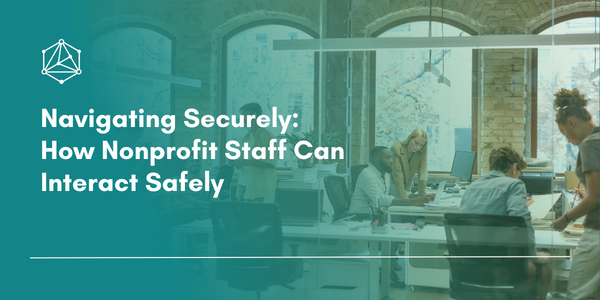For nonprofit organizations, effective and instantaneous interaction with clients, donors, and help desk staff is critical. While the digital landscape has opened new avenues for communication and collaboration, it also has brought potential risks and challenges. At CTD, we understand the importance of safeguarding sensitive information and maintaining the trust of nonprofit stakeholders. Here are some tips and insights we often share with nonprofit staff on how to exercise caution when interacting with clients, donors, and even help desk personnel to ensure that they are communicating in a secure and trustworthy environment.
Recognizing Social Engineering Tactics
One of today’s most prevalent cyber threats is social engineering. That’s when cybercriminals research victims, gain their trust and then manipulate them into divulging sensitive information or performing other actions that will leave an organization’s systems vulnerable. Nonprofit staff should be vigilant in recognizing common social engineering tactics, such as phishing emails, fake websites, or unsolicited requests for personal information. Your IT team should emphasize the importance of verifying the legitimacy of any communication, especially if it involves financial transactions or the sharing of confidential data.
Phishing Awareness and Prevention
Likewise, phishing attacks remain a persistent threat, and nonprofit staff should be well-versed in recognizing and thwarting them. Educate employees on the characteristics of phishing emails, such as suspicious links, generic greetings, fraudulent email addresses, and urgent calls to action. Remind staff to avoid clicking on unknown links or downloading attachments from unfamiliar sources, as these may contain malware or lead to phishing websites. Your MSP can implement email filtering solutions to identify and quarantine potential phishing attempts.
Secure Communication Channels
In the interconnected world of nonprofits, communication with clients, donors, and help desk staff often involves various channels, including email, phone calls, and messaging platforms. It’s crucial to utilize secure communication channels to protect sensitive information from unauthorized access. Your MSP should encourage the use of encrypted email services, secure messaging apps, and virtual private networks to add an extra layer of protection to communication channels.
Data Privacy and Confidentiality Training
Nonprofit staff should undergo regular training from their IT team on data privacy and confidentiality practices. Ensure that employees understand the importance of safeguarding sensitive information and adhering to privacy regulations. Training sessions should cover the proper handling of donor information, client data, and any confidential details. Emphasize the significance of not sharing passwords or login credentials and the importance of reporting any suspicious activity promptly.
Verifying Client and Donor Identities
When interacting with clients and donors, it’s essential to establish and verify their identities to prevent unauthorized access or fraudulent activities. Encourage staff to adopt a multi-step verification process, especially for financial transactions or changes to account information. This can include phone verification, secure login methods, or the use of unique access codes. Verifying identities helps ensure that the nonprofit is engaging with legitimate stakeholders.
Establishing Clear Communication Protocols
Your internal IT team should establish clear communication protocols when interacting with clients, donors, and help desk personnel. Define the channels through which sensitive information should be shared and establish guidelines for doing so securely. Encourage staff to use official communication channels for work-related discussions and avoid sharing confidential information through unsecured platforms. Consistent adherence to communication protocols helps minimize the risk of information leakage.
Securing Devices and Workstations
In the age of remote work, nonprofit staff often use personal devices to access organizational networks and data. If you must use them, it’s imperative to emphasize the importance of securing these devices to prevent unauthorized access. Encourage the use of strong passwords, enable device encryption, and implement security features such as biometric authentication where possible. Have your IT team regularly update software and operating systems to patch vulnerabilities and protect against potential exploits.
Donor Payment Security
For nonprofit organizations, donor payments are a critical aspect of fundraising. Implement secure payment processing systems that comply with industry standards for handling financial transactions. Encourage donors to use reputable and secure payment methods and educate staff on recognizing potential payment fraud or unauthorized transactions. Regularly review and update payment processing protocols to align with the latest security standards.
Transparent Help Desk Interactions
Help desk staff play a crucial role in supporting nonprofit operations. When interacting with help desk personnel, nonprofit staff should prioritize transparency and verification. Ensure that staff members are aware of the proper procedures for seeking help and verifying the identity of help desk representatives. Encourage the use of official help desk channels and avoid sharing sensitive information without proper authentication. This cautious approach helps prevent unauthorized access or the inadvertent disclosure of confidential details.
Normalize Security Awareness Training
Ongoing security awareness training is essential for nonprofit staff to stay abreast of emerging threats and best practices. Your internal IT team and/or outside IT professionals should conduct regular training sessions covering topics such as cybersecurity hygiene, password management, and the identification of social engineering tactics. Use real-world examples and scenarios that are pulled from current news situations to reinforce the importance of exercising caution in various situations. By instilling a culture of security awareness, nonprofit staff can contribute to the overall resilience of the organization against potential threats.
In the digital era, the success of nonprofit organizations hinges on effective and secure interactions with clients, donors, and help desk personnel. By implementing the tips outlined in this article, nonprofits can help their staff navigate the complexities of the digital landscape while safeguarding sensitive information and maintaining the trust of stakeholders. AT CTD, we are committed to supporting nonprofits in their missions, so we emphasize the importance of fostering a culture of awareness. Need help with cybersecurity? Reach out to us to learn how our team can implement enterprise-grade security and encryption and take full advantage of the latest security systems to minimize the risk of cyberattacks.

